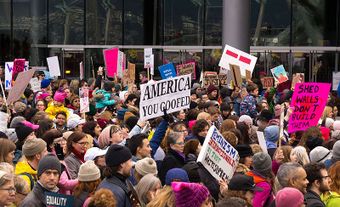The Front de libération des femmes du Québec (FLF) was a militant feminist organization that was active from 1969 to 1971. Even though it was around for such a short time, the FLF played an important role in the history of Quebec society. The FLF popularized a feminist analysis that linked the oppression of women with the Quebec nationalist cause. Its efforts led to the elimination of Quebec’s prohibition against women serving as jurors, as well as to government-funded daycare centres and accessible abortion services.

(Photo by Antoine Desilets/BAnQ/Fonds Antoine Desilets/611396)
Key Concept
Patriarchy: system that has enabled men to dominate women throughout history and perpetuates inequality between men and women
Historical Background
The late 1960s was a time of political and social ferment in Quebec. Politically, this period saw the rise of a Quebec nationalist movement, including a radical component, the Front de libération du Québec (FLQ), that was influenced by Marxism and international anticolonialist movements. Many of the women activists who formed the FLF came from this radical nationalist background.
During the 1960s, the Quebec women’s movement became organized and founded several large organizations such as the Fédération des femmes du Québec (FFQ). These organizations had a reformist tendency, advocating changes to advance the cause of women within existing political structures. The women activists who founded the FLF were more radical and called for genuine revolution.
When the FLF was founded, its members included both francophone and anglophone women, many from left-wing groups with close ties to the trade union movement. But this alliance between francophones and anglophones quickly fell apart as the FLF embraced a revolutionary nationalism aimed at liberating Quebec from Anglo-Saxon colonialism. At that time in Quebec, there were major income inequalities running along lines of language and ethnicity, and the social class system was stratified accordingly. From a Marxist perspective, Quebec anglophones were thus seen as the dominant group against whom the class struggle had to be directed.
For the members of the FLF, the main enemy was the patriarchal system, grounded in the colonialism through which British, English-Canadian and American capitalists had been controlling and exploiting Quebec for the past 200 years. Women struggling against this patriarchy united with the forces fighting for socialism and Quebec independence, as expressed in the slogan “No women’s liberation without Quebec liberation. No Quebec liberation without women’s liberation”.
FLF Structure and Activities
The FLF’s members were organized into groups called cells, each of which was non-hierarchical and fully autonomous. These various cells reflected the FLF’s various concerns and demands.
The Abortion cell provided resources to women seeking to terminate unwanted pregnancies, at a time when abortion was still a criminal offence in Canada. The Daycare cell founded one of the first “people’s daycare centres” and demanded the establishment of a universal daycare system. The Newspaper cell founded the newspaper Québécoises deboutte!. A cell called Les patates collent focused on criticizing the Salon de la femme, an annual event that it accused of perpetuating sexism and contributing to the oppression of women.
The FLF also provided support to women workers on picket lines during labour conflicts, as a way of helping to fight class inequalities.
Campaign for Women Jurors
One of the FLF’s most important fights was to end the prohibition against women’s serving on juries in Quebec. In March 1971, a woman named Lise Balcer had refused to testify at the trial of an FLQ member and so found herself on trial for contempt of court, before an all-male jury. In a spectacular protest gesture, seven members of the FLF occupied the jury box, shouting “La justice c’est d’la marde! (Justice is shit!)”. They were promptly arrested and had to face prison sentences. But scarcely three months later, the law was changed so that women could serve on juries in Quebec. By attacking the court, the FLF militants had shown how deeply rooted patriarchal values were in Quebec’s legal institutions.
Newspaper Québécoises deboutte!
The FLF used its newspaper, Québécoises deboutte!, to communicate the group’s ideas. In its first issue, in November 1971, the members presented their collective plans for the newspaper. They also summarized their analysis of the social and political issues of the day: that women were exploited, and that this exploitation was not due to any intrinsic differences between women and men.
The authors defined themselves as a group of women of all ages, some of whom had children and some of whom did not, but all of whom shared the conviction that a newspaper was essential for them to analyze all aspects of the oppression of women and find ways of uniting to fight it. This newspaper published hard-hitting articles denouncing the many faces of the oppression of women in both the domestic and the public spheres.
End of the FLF
In 1971, after just two years marked by intense debates and spectacular actions that helped to change Quebec society, the FLF’s activists decided to end their experiment—some because they were suffering from burnout, others because they wanted to work through a more structured organization.
Nevertheless, in 1972, members of the Abortion cell helped to establish the Centre des femmes (women’s centre), which continued the discussions and struggles begun by the FLF and continued to publish Québécoises deboutte! until 1974.

 Share on Facebook
Share on Facebook Share on X
Share on X Share by Email
Share by Email Share on Google Classroom
Share on Google Classroom
.jpg)
